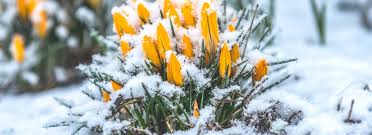By Becky Novak
One day it is 65°F and sunny, and the next it is 32°F with snow on the ground. Yep, that’s spring—a magical time of year filled with burgeoning life and fluctuating thermometers. I don’t know about you, but last week’s weather really had my garden running scared. A late spring snow or freeze can really damage our plants. I know we planned on discussing what to plant this week in our raised beds, however, I would like to take a moment to share some tips on how to protect your plants from frost/snow damage.
The first thing to keep in mind is that a day of snow is not likely to do much harm to your plants. The soil is already workable (or you would not have planted anything) and one day of weird weather is not enough to make it freeze up again even if there is a freeze.
The only real danger that comes with snow is the weight of it on your vegetable plants, especially if they are still pretty small. A light dusting will not do much harm, but an inch or two covering tiny, newly planted veggie starts could mean you will have to replant the garden. The weight can snap off stems or leave them so weak that they may not grow properly.
To eliminate this issue altogether, your best option is to cover your plants. You can use anything. Here are some ideas to cover your plants so they are not exposed to snow at all. That way, you will not have to worry about the cold or the weight of snow from harming them.
- Cardboard box: Use a cardboard box to cover plants—you could even cut in some holes on the sides for air. Just remove it as soon as possible to let your plants get the light they need, as the cardboard will prevent plants from getting light.
- Plastic milk jug, juice bottle, or soda bottle with the bottom cut out: These are good at fitting over individual plants.
- Plastic storage bin: A clear bin will protect the plant while letting light in. If it’s not clear, remove the bin as soon as possible once the snow stops.
- Plastic tarp or drop cloth held up with garden stakes or large pots: This is another way to protect your garden from the snow.
- Plastic bag: Your standard grocery bag fits over smaller plants and can keep blooms from getting broken or too cold.
Be sure to remove the coverings first thing in the morning after an overnight cold snap. If you do not do so, condensation can build up and freeze again under the covering, which will damage the plant.
With just a little bit of preparation and caution, your early veggies will make it through a freak spring snow just fine. Next week, we will get back to fun veggies for our gardens. Good luck with your gardens this spring!
























